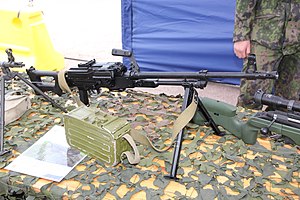PK machine gun
| PK machine gun | |
|---|---|

PKM general-purpose machine gun with modern black polymer furniture and a 100-round ammunition box
|
|
| Type | General-purpose machine gun |
| Place of origin | Soviet Union |
| Service history | |
| In service | 1961–present |
| Used by | See Users |
| Wars |
Vietnam War South African Border War Cambodian Civil War Cambodian–Vietnamese War Sino-Vietnamese War Soviet–Afghan War Iran–Iraq War Nagorno-Karabakh War Gulf War Somali Civil War Yugoslav Wars First Chechen War Second Chechen War War in Afghanistan Iraq War Cambodian–Thai border dispute Russo-Georgian War Libyan Civil War Syrian Civil War Northern Mali conflict War in Donbass Yemeni Civil War |
| Production history | |
| Designer | Mikhail Kalashnikov |
| Designed | 1960 |
| Manufacturer | Degtyarev plant |
| Produced | 1961–present |
| Number built | 1,000,000 |
| Variants | See Variants |
| Specifications | |
| Weight | PK: 9 kg (19.84 lb) (gun + integral bipod) + 7.7 kg (16.98 lb) (tripod). PKM: 7.5 kg (16.53 lb) (gun + integral bipod) + 4.5 kg (9.92 lb) (tripod). PKTM (tank): 10.5 kg (23.15 lb) |
| Length | PK: 1,203 mm (47.4 in) PKM: 1,192 mm (46.9 in) PKT: 1,098 mm (43.2 in) |
| Barrel length | PK(M): 605 mm (23.8 in) (without muzzle device) PKT: 772 mm (30.4 in) |
|
|
|
| Cartridge | 7.62×54mmR |
| Action | Gas-operated, open bolt |
| Rate of fire | PK, PKM: 650 rounds/min PKT: 700 - 800 rounds/min Practical: 250 rounds/min |
| Muzzle velocity | PK, PKM: 825 m/s (2,707 ft/s) PKT: 855 m/s (2,805 ft/s) |
| Effective firing range | PK(M): 1,000 m (1,094 yd) (100–1,500 m sight adjustments) PKT: 1,500 m (1,640 yd) (100–1,500 m sight adjustments) |
| Maximum firing range | PK(M): 3,800 m (4,156 yd) PKT: 4,000 m (4,374 yd) |
| Feed system | Non-disintegrating metal belts in 100 and 200/250 round ammunition boxes |
| Sights | Tangent iron sights (default); Optical, Night-vision, Thermal and Radar sights |
The PK (Russian: Пулемёт Калашникова, transliterated as Pulemyot Kalashnikova, or "Kalashnikov's Machinegun"), is a 7.62 mm general-purpose machine gun designed in the Soviet Union and currently in production in Russia. The original PK machine gun was introduced in 1961 and then the improved PKM in 1969 to replace the SGM and RP-46 machine guns in Soviet service. It remains in use as a front-line infantry and vehicle-mounted weapon with Russia's armed forces. The PK has been exported extensively and produced in several other countries under license.
The Main Artillery Directorate of the Soviet Union adopted specification requirements for a 7.62 mm general-purpose company- and battalion-level machine gun, chambered for a rifle cartridge in 1955. In 1958 a machine gun prototype, developed by G.I. Nikitin and Yuri M. Sokolov, successfully passed field tests. Based on the results of the tests it was decided in 1960 to manufacture a batch of Nikitin-Sokolov machine guns for service tests and then put the machine gun into production at the Kovrov Mechanical Plant. When the Nikitin-Sokolov machine gun was almost completed, a team of Izhevsk Mechanical Plant designers, headed by M.T. Kalashnikov, and further consisting of M.T. Kalashnikov, V.V. Krupin, V.N. Pushchin, A.D. Kryakushin, as well as Startsev, Kamzolov, Koryakovtsev, Yuferev, joined the competition. Their machine gun prototype was based on the well-proven gas-operated rotary-bolt design of the Kalashnikov-pattern arms. The Kalashnikov and the Nikitin-Sokolov prototypes underwent service tests in the Central Asia, the Odessa, and the Baltic military districts, as well as at the Vystrel officer training courses in late 1960. The Main Missiles and Artillery Directorate and the Ministry of the Defence Industry preferred the Kalashnikov design. The Kalashnikov design was found to be more reliable and cheaper to manufacture than the design of Grigory Nikitin and Yuri Sokolov. The PK/PKS was put into production at the Kovrov Mechanical Plant and used the tripod mount and an ammunition belt boxes originally designed for the Nikitin-Sokolov prototype machine gun.
...
Wikipedia
